Modeling Hurricane Wave Forces Acting on Coastal Bridges by Artificial Neural Networks
Abstract
1. Introduction
2. Description of Shallow FFNN and Deep LSTM Methodology
2.1. Shallow FFNN for Wave Load Modeling
2.2. Deep LSTM Neural Network for Wave Load Modeling
2.3. General Neural Network Training and Verification Process
3. Case Study I: Simulation of Wave Loads During Hurricane Katrina for Submerged Bridge Deck in Biloxi Bay
3.1. Data Obtained from Full-Scale Numerical Wave Model Simulations of Biloxi Bay Bridge
3.2. Shallow FFNN Training and Verification for Wave Loads for Hurricane Katrina
3.3. Deep LSTM Training and Verification for Wave Loads During Hurricane Katrina
3.4. Comparison of FFNN and LSTM for Hurricane Katrina Case Study
4. Case Study II: Simulation of Wave Loads During Hurricane Ivan for Emerged Bridge Deck in Escambia Bay
4.1. Data Obtained from Full-Scale Numerical Wave Model Simulations of Escambia Bay Bridge
4.2. Shallow FFNN Training and Verification for Hurricane Ivan
4.3. Deep LSTM Training and Verification for Wave Forces During Hurricane Ivan
4.4. Comparison of Shallow FFNN and Deep LSTM for Hurricane Ivan
5. Discussion
5.1. Data Gaps and Noise
5.2. Neural Network Versus Numerical Wave Load Model
5.3. Shallow FFNN vs. Deep LSTM Neural Networks
5.4. Effect of Network Size
5.5. Spatial and Temporal Neural Network Modeling
5.6. Limitation of Bridge Geometry
6. Conclusions
Author Contributions
Funding
Data Availability Statement
Conflicts of Interest
References
- Cruz, A.M.; Krausmann, E. Damage to Offshore Oil and Gas Facilities Following Hurricanes Katrina and Rita: An Overview. J. Loss Prev. Process Ind. 2008, 21, 620–626. [Google Scholar] [CrossRef]
- BOEM (Bureau of Ocean Energy Management). Newsroom Release #3486. Date: May 1, 2006. MMS Updates Hurricanes Katrina and Rita Damage. Available online: https://www.boem.gov/sites/default/files/boem-newsroom/Press-Releases/2006/press0501.pdf (accessed on 26 October 2025).
- Okeil, A.M.; Cai, C.S. Survey of Short- and Medium-Span Bridge Damage Induced by Hurricane Katrina. J. Bridge Eng. 2008, 13, 377–387. [Google Scholar] [CrossRef]
- Fan, X.; Zhang, J.; Liu, H. Numerical Analysis on the Secondary Load Cycle on a Vertical Cylinder in Steep Regular Waves. Ocean Eng. 2018, 168, 133–139. [Google Scholar] [CrossRef]
- Xie, P.; Chu, V.H. The Forces of Tsunami Waves on a Vertical Wall and on a Structure of Finite Width. Coast. Eng. 2019, 149, 65–80. [Google Scholar] [CrossRef]
- Xie, P.W.; Chu, V.H. The Impact of Tsunami Wave Force on Elevated Coastal Structures. Coast. Eng. 2020, 162, 103777. [Google Scholar] [CrossRef]
- Miao, Y.; Wang, K.H. Interaction between a Solitary Wave and a Fixed Partially Submerged Body with Two Extended Porous Walls. J. Eng. Mech. 2021, 147, 04021038. [Google Scholar] [CrossRef]
- Chen, M.; Huang, B.; Yang, Z.; Liao, L.; Zhou, J.; Ren, Q.; Zhu, B. Study on the Mechanical Characteristics and Failure Mechanism of the Coastal Bridge with a Box-Girder Superstructure under the Action of Breaking Solitary Waves. Ocean Eng. 2023, 287, 115834. [Google Scholar] [CrossRef]
- Yang, Z.; Zhu, B.; Huang, B.; Hou, J.; Zhang, Y.; Li, L. Numerical Study on the Behaviors of Coastal Bridges with Box Girder under the Action of Extreme Waves. Ocean Eng. 2023, 286, 115683. [Google Scholar] [CrossRef]
- Huang, W.; Xiao, H. Numerical Modeling of Dynamic Wave Force Acting on Escambia Bay Bridge Deck during Hurricane Ivan. J. Waterw. Port Coast. Ocean Eng. 2009, 135, 164–175. [Google Scholar] [CrossRef]
- Xiao, H.; Huang, W.; Chen, Q. Effects of Submersion Depth on Wave Uplift Force Acting on Biloxi Bay Bridge Decks during Hurricane Katrina. Comput. Fluids 2010, 39, 1390–1400. [Google Scholar] [CrossRef]
- NorthEscambia.com News. Available online: https://www.northescambia.com/2024/09/20-years-later-ivan-the-terrible (accessed on 19 October 2025).
- Floriano, B.; Hanson, B.; Bewley, T.; Ishihara, J.Y.; Ferreira, H.C. A Novel Policy for Coordinating a Hurricane Monitoring System Using a Swarm of Buoyancy-Controlled Balloons Trading off Communication and Coverage. Eng. Appl. Artif. Intell. 2025, 139, 109495. [Google Scholar] [CrossRef]
- Fatima, K.; Shareef, H.; Costa, F.B.; Bajwa, A.A.; Wong, L.A. Machine Learning for Power Outage Prediction during Hurricanes: An Extensive Review. Eng. Appl. Artif. Intell. 2024, 133, 108056. [Google Scholar] [CrossRef]
- Kufel, J.; Bargiel-Laczek, K.; Kocot, S.; Kozlik, M.; Bartnikowska, W.; Janik, M.; Czogalik, Ł.; Dudek, P.; Magiera, M.; Lis, A.; et al. What Is Machine Learning, Artificial Neural Networks and Deep Learning? Examples of Practical Applications in Medicine. Diagnostics 2023, 13, 2582. [Google Scholar] [CrossRef] [PubMed]
- IBM. IBM Data and AI Team. 2016. Available online: https://www.ibm.com/blog/ai-vs-machine-learning-vs-deep-learning-vs-neural-networks (accessed on 30 September 2024).
- Kim, D.E.; Gofman, M. Comparison of Shallow and Deep Neural Networks for Network Intrusion Detection. In Proceedings of the 2018 IEEE 8th Annual Computing and Communication Workshop and Conference (CCWC), Las Vegas, NV, USA, 8–10 January 2018; pp. 204–208. [Google Scholar]
- Emmert-Streib, F.; Yang, Z.; Feng, H.; Tripathi, S.; Dehmer, M. An Introductory Review of Deep Learning for Prediction Models with Big Data. Front. Artif. Intell. 2020, 3, 4. [Google Scholar] [CrossRef] [PubMed]
- Li, Q.; Luo, S.; Chen, Z.; Yang, C.; Zhang, J. Tactile Sensing, Skill Learning, and Robotic Dexterous Manipulation; Elsevier: Amsterdam, The Netherlands, 2022. [Google Scholar]
- Zhu, D.; Zhang, J.; Wu, Q.; Dong, Y.; Bastidas-Arteaga, E. Predictive Capabilities of Data-Driven Machine Learning Techniques on Wave-Bridge Interactions. Appl. Ocean. Res. 2023, 137, 103597. [Google Scholar] [CrossRef]
- Kar, S.; McKenna, J.R.; Sunkara, V.; Coniglione, R.; Stanic, S.; Bernard, L. XWaveNet: Enabling Uncertainty Quantification in Short-Term Ocean Wave Height Forecasts and Extreme Event Prediction. Appl. Ocean Res. 2024, 148, 103994. [Google Scholar] [CrossRef]
- Liu, R.W.; Hu, K.; Liang, M.; Li, Y.; Liu, X.; Yang, D. QSD-LSTM: Vessel Trajectory Prediction Using Long Short-Term Memory with Quaternion Ship Domain. Appl. Ocean Res. 2023, 136, 103592. [Google Scholar] [CrossRef]
- Wang, N.; Chen, Q.; Wang, H.; Capurso, W.D.; Niemoczynski, L.M.; Zhu, L.; Snedden, G.A. Field Observations and Long Short-Term Memory Modeling of Spectral Wave Evolution at Living Shorelines in Chesapeake Bay, USA. Appl. Ocean Res. 2023, 141, 103782. [Google Scholar] [CrossRef]
- Wu, G.K.; Li, R.Y.; Li, D.W. Research on Numerical Modeling of Two-Dimensional Freak Waves and Prediction of Freak Wave Heights Based on LSTM Deep Learning Networks. Ocean Eng. 2024, 311, 119032. [Google Scholar] [CrossRef]
- Zhang, M.; Yuan, Z.M.; Dai, S.S.; Chen, M.L.; Incecik, A. LSTM RNN-Based Excitation Force Prediction for the Real-Time Control of Wave Energy Converters. Ocean Eng. 2024, 306, 118023. [Google Scholar] [CrossRef]
- Alizadeh, M.J.; Nourani, V. Multivariate GRU and LSTM Models for Wave Forecasting and Hindcasting in the Southern Caspian Sea. Ocean Eng. 2024, 298, 117193. [Google Scholar] [CrossRef]
- Wang, M.; Ying, F. A Hybrid Model for Multistep-Ahead Significant Wave Height Prediction Using an Innovative Decomposition-Reconstruction Framework and E-GRU. Appl. Ocean Res. 2023, 140, 103752. [Google Scholar] [CrossRef]
- Luo, Q.R.; Xu, H.; Bai, L.H. Prediction of Significant Wave Height in Hurricane Area of the Atlantic Ocean Using the Bi-LSTM with Attention Model. Ocean Eng. 2022, 266, 110019. [Google Scholar] [CrossRef]
- Yan, J.; Zhang, Y.; Su, Q.; Li, R.; Li, H.; Lu, Z.; Lu, H.; Lu, Q. Time Series Prediction Based on LSTM Neural Network for Top Tension Response of Umbilical Cables. Mar. Struct. 2023, 91, 103448. [Google Scholar] [CrossRef]
- Zheng, Z.Y.; Wang, S.; Liu, Y.; Liu, C.; Xie, W.; Fang, C.; Liu, S. A Novel Equivalent Model of Active Distribution Networks Based on LSTM. IEEE Trans. Neural Netw. Learn. Syst. 2019, 30, 2611–2624. [Google Scholar] [CrossRef]
- Xue, H.; Huynh, D.Q.; Reynolds, M. PoPPL: Pedestrian Trajectory Prediction by LSTM With Automatic Route Class Clustering. IEEE Trans. Neural Netw. Learn. Syst. 2021, 32, 77–90. [Google Scholar] [CrossRef]
- Chen, H.; Lin, R.; Zeng, W. Short-Term Load Forecasting Method Based on ARIMA and LSTM. In Proceedings of the 2022 IEEE 22nd International Conference on Communication Technology (ICCT), Nanjing, China, 11–14 November 2022; pp. 1913–1917. [Google Scholar]
- Lu, H.; Wang, Q.; Tang, W.; Liu, H. Physics-Informed Neural Networks for Fully Non-Linear Free Surface Wave Propagation. Phys. Fluids 2024, 36, 062106. [Google Scholar] [CrossRef]
- Chen, Q.; Wang, N.; Chen, Z. Simultaneous Mapping of Nearshore Bathymetry and Waves Based on Physics-Informed Deep Learning. Coast. Eng. 2023, 183, 104337. [Google Scholar] [CrossRef]
- Ahn, Y.; Kim, Y. Data Mining in Sloshing Experiment Database and Application of Neural Network for Extreme Load Prediction. Mar. Struct. 2021, 80, 103074. [Google Scholar] [CrossRef]
- Altunkaynak, A.; Wang, K.H. A Comparative Study of Hydrodynamic Model and Expert System Related Models for Prediction of Total Suspended Solids Concentrations in Apalachicola Bay. J. Hydrol. 2011, 400, 353–363. [Google Scholar] [CrossRef]
- Portillo, N.; Negro, V. Review of the Application of Artificial Neural Networks in Ocean Engineering. Ocean Eng. 2022, 259, 111947. [Google Scholar] [CrossRef]
- Truong, T.T.; Dinh-Cong, D.; Lee, J.; Nguyen-Thoi, T. An Effective Deep Feedforward Neural Networks (DFNN) Method for Damage Identification of Truss Structures Using Noisy Incomplete Modal Data. J. Build. Eng. 2020, 30, 101244. [Google Scholar] [CrossRef]
- Le, H.Q.; Truong, T.T.; Dinh-Cong, D.; Nguyen-Thoi, T. A Deep Feed-Forward Neural Network for Damage Detection in Functionally Graded Carbon Nanotube-Reinforced Composite Plates Using Modal Kinetic Energy. Front. Struct. Civ. Eng. 2021, 15, 1453–1479. [Google Scholar] [CrossRef]
- Vasireddi, H.K.; Suganya Devi, K.; Raja Reddy, G.N.V. Deep Feed Forward Neural Network-Based Screening System for Diabetic Retinopathy Severity Classification Using the Lion Optimization Algorithm. Graefes Arch. Clin. Exp. Ophthalmol. 2022, 260, 1245–1263. [Google Scholar] [CrossRef] [PubMed]
- Gupta, T.K.; Raza, K. Optimizing Deep Feedforward Neural Network Architecture: A Tabu Search Based Approach. Neural Process. Lett. 2020, 51, 2855–2870. [Google Scholar] [CrossRef]
- Yang, J.; Li, J.; Yan, S.; Wang, Y.; Zhang, Y.; Yan, X. Fluid Catalytic Cracking Process Quality-Driven Fault Detection Based on Partial Least Squares and Deep Feedforward Neural Network. Trans. Inst. Meas. Control 2024, 46, 78–92. [Google Scholar] [CrossRef]
- Deo, M.C.; Jha, A.; Chaphekar, A.S.; Ravikant, K. Neural Networks for Wave Forecasting. Ocean Eng. 2001, 28, 889–898. [Google Scholar] [CrossRef]
- Patil, K.; Deo, M.C. Prediction of Daily Sea Surface Temperature Using Efficient Neural Networks. Ocean Dyn. 2017, 67, 357–368. [Google Scholar] [CrossRef]
- Sadeghifar, T.; Lama, G.F.C.; Sihag, P.; Bayram, A.; Kisi, O. Wave Height Predictions in Complex Sea Flows through Soft-Computing Models: Case Study of Persian Gulf. Ocean Eng. 2022, 245, 110467. [Google Scholar] [CrossRef]
- Tsai, J.C.; Tsai, C.H. Wave Measurements by Pressure Transducers Using Artificial Neural Networks. Ocean Eng. 2009, 36, 1149–1157. [Google Scholar] [CrossRef]
- Lee, J.B.; Roh, M.I.; Kim, K.S. Prediction of Ship Power Based on Variation in Deep Feed-Forward Neural Network. Int. J. Nav. Archit. Ocean Eng. 2021, 13, 641–649. [Google Scholar] [CrossRef]
- Zhao, Y.; Dong, S.; Jiang, F.; Incecik, A. Mooring Tension Prediction Based on BP Neural Network for Semi-Submersible Platform. Ocean Eng. 2021, 223, 108714. [Google Scholar] [CrossRef]
- Chen, Q.; Mao, P.; Zhu, S.; Xu, X.; Feng, H. A Decision-Aid System for Subway Microenvironment Health Risk Intervention Based on Backpropagation Neural Network and Permutation Feature Importance Method. Build. Environ. 2024, 253, 111292. [Google Scholar] [CrossRef]
- Gao, H.; Qian, W.; Dong, J.; Liu, J. Rapid Prediction of Indoor Airflow Field Using Operator Neural Network with Small Dataset. Build. Environ. 2024, 251, 111175. [Google Scholar] [CrossRef]
- Wu, L.; Yang, Y.; Maheshwari, M. Strain Prediction for Critical Positions of FPSO under Different Loading of Stored Oil Using GAIFOABP Neural Network. Mar. Struct. 2020, 72, 102762. [Google Scholar] [CrossRef]
- Gabella, M. Topology of Learning in Feedforward Neural Networks. IEEE Trans. Neural Netw. Learn. Syst. 2021, 32, 3588–3592. [Google Scholar] [CrossRef]
- Li, H.; Zhang, L. A Bilevel Learning Model and Algorithm for Self-Organizing Feed-Forward Neural Networks for Pattern Classification. IEEE Trans. Neural Netw. Learn. Syst. 2021, 32, 4901–4915. [Google Scholar] [CrossRef]
- Zhang, S.; Liu, Y. Forecasting Model of Total Import and Export Based on ARIMA Algorithm Optimized by BP Neural Network. In Proceedings of the 2023 IEEE 3rd International Conference on Data Science and Computer Application (ICDSCA), Dalian, China, 27–29 October 2023; pp. 1534–1538. [Google Scholar]
- Huang, W.; Foo, S. Neural Network Modeling of Salinity Variation in Apalachicola River. Water Res. 2002, 36, 356–362. [Google Scholar] [CrossRef]
- Huang, W.; Murray, C.; Kraus, N.; Rosati, J. Development of a Regional Neural Network for Coastal Water Level Predictions. Ocean Eng. 2003, 30, 2275–2295. [Google Scholar] [CrossRef]
- Huang, W.; Xu, S. Neural Network and Harmonic Analysis for Recovering Missing Extreme Water-Level Data during Hurricanes in Florida. J. Coast. Res. 2009, 25, 417–426. [Google Scholar] [CrossRef]
- Huang, W.; Murray, C. Multiple-Station Neural Network for Modelling Tidal Currents Across Shinnecock Inlet, USA. Hydrol. Process. 2008, 22, 1136–1149. [Google Scholar] [CrossRef]
- Le, D.; Huang, W.; Johnson, E. Neural Network Modeling of Monthly Salinity Variations in Oyster Reef in Apalachicola Bay in Response to Freshwater Inflow and Winds. Neural Comput. Appl. 2019, 31, 6249–6259. [Google Scholar] [CrossRef]
- Huang, W.; Xu, B.; Chan-Hilton, A. Forecasting flow in Apalachicola River using neural network. Int. J. Hydrol. Process. 2004, 18, 2545–2564. [Google Scholar] [CrossRef]
- Huang, W.; Cai, Y.; Chao, Y.N.; Teng, F.; Xu, S.D.; Wang, B.B. Neural Network Modelling of Flow in Yinluoxia Station Based on Flow in Zhamashike Station in Heihe River, China. Adv. Intell. Syst. Res. 2015, 123, 206–209. [Google Scholar]
- Herrera, S.R.; Ceberio, M.; Kreinovich, V. When Is Deep Learning Better and When Is Shallow Learning Better: Qualitative Analysis; Technical Report UTEP-CS-22-1691; University of Texas at El Paso: El Paso, TX, USA, 2022. [Google Scholar]
- Meir, Y.; Tevet, O.; Tzach, Y.; Hodassman, S.; Gross, R.D.; Kanter, I. Efficient Shallow Learning as an Alternative to Deep Learning. Sci. Rep. 2023, 13, 5423. [Google Scholar] [CrossRef]
- Haykin, S. Neural Networks: A Comprehensive Foundation, 2nd ed.; Prentice Hall: Upper Saddle River, NJ, USA, 1999. [Google Scholar]
- Hagan, M.T.; Demuth, H.; Beale, M. Neural Network Design; PWS Publishing: Boston, MA, USA, 1995. [Google Scholar]
- Mandal, S.; Prabaharan, N. Ocean Wave Forecasting Using Recurrent Neural Networks. Ocean Eng. 2006, 33, 1401–1410. [Google Scholar] [CrossRef]
- Fitch, J.P.; Lehman, S.K.; Dowla, F.U.; Lu, S.K.; Johansson, E.M.; Goodman, D.M. Ship Wake Detection Procedure Using Conjugate Gradient Trained Artificial Neural Network. IEEE Trans. Geosci. Remote Sens. 1991, 9, 718–725. [Google Scholar] [CrossRef]
- Rehman, K.U.; Shatanawi, W.A.; Mustafa, Z. Levenberg–Marquardt Backpropagation Neural Networking (LMB-NN) Analysis of Hydrodynamic Forces in Fluid Flow over Multiple Cylinders. AIP Adv. 2024, 14, 025051. [Google Scholar] [CrossRef]
- MathWorks. Deep Learning Toolbox. 2024. Available online: https://www.mathworks.com/products/deep-learning.html (accessed on 30 September 2024).
- Fletcher, D.; Goss, E. Forecasting with Neural Networks: An Application Using Bankruptcy Data. Inf. Manag. 1993, 24, 159–167. [Google Scholar] [CrossRef]
- Hochreiter, S.; Schmidhuber, J. Long Short-Term Memory. Neural Comput. 1997, 9, 1735–1780. [Google Scholar] [CrossRef]
- Xiao, H.; Huang, W. Numerical modeling of wave runup and forces acting on beachfront house. Ocean Eng. 2008, 35, 106–116. [Google Scholar] [CrossRef]
- Xiao, H.; Huang, W. Effects of turbulence models on numerical simulations of wave breaking and run-up on a mild slope beach. J. Hydrodyn. 2010, 22, 166–171. [Google Scholar] [CrossRef]
- Xiao, H.; Huang, W. Three-dimensional numerical modeling of solitary wave breaking and force on a cylinder pile in the coastal surf zone. J. Eng. Mech. 2015, 141, 04015007. [Google Scholar] [CrossRef]
- Xiao, H.; Huang, W. Failure mechanism and risk analysis of an elevated house damaged during Hurricane Michael by full-scale modeling of wave-surge loads. Ocean Eng. 2024, 300, 117387. [Google Scholar] [CrossRef]
- Xiao, H.; Huang, W.; Tao, J. Numerical modeling of wave overtopping a levee during Hurricane Katrina. Comput. Fluids 2009, 38, 991–996. [Google Scholar] [CrossRef]
- Xiao, H.; Huang, W.; Tao, J.; Liu, C. Numerical modeling of wave-current forces acting on horizontal cylinder of marine structures by VOF method. Ocean Eng. 2013, 67, 58–67. [Google Scholar] [CrossRef]
- Fenton, J.D.; Rienecker, M.M. A Fourier method for solving nonlinear water-wave problems: Application to solitary-wave interactions. J. Fluid Mech. 1982, 118, 411–443. [Google Scholar] [CrossRef]
- French, J.A. Wave Uplift Pressure on Horizontal Platforms; Report No. KH-R-19; W.M. Keck Laboratory of Hydraulics and Water Resources, California Institute of Technology: Pasadena, CA, USA, 1969. [Google Scholar]
- Park, H.; Trung, D.; Tomiczek, T.; Cox, D.T.; van de Lindt, J.W. Numerical modeling of non-breaking, impulsive breaking, and broken wave interaction with elevated coastal structures: Laboratory validation and inter-model comparisons. Ocean Eng. 2018, 158, 78–98. [Google Scholar] [CrossRef]
- Wang, J.; Liu, R.; Xiao, H. Point-cloud neural network framework for high-resolution velocity field reconstruction in wave-structure interaction. Ocean Eng. 2025, 340, 122223. [Google Scholar] [CrossRef]
- Huang, W.; Yin, K.; Ghorbanzadeh, M.; Ozguven, E.E.; Xu, S.; Vijayan, L. Integrating Storm Surge Modeling with Traffic Data Analysis to Evaluate the Effectiveness of Hurricane Evacuation. Front. Struct. Civ. Eng. 2022, 15, 1301–1316. [Google Scholar] [CrossRef]
- Vijayan, L.; Huang, W.; Yin, K.; Ozguven, E.; Burns, S.; Ghorbanzadeh, M. Evaluation of parametric wind models for more accurate modeling of storm surge: A case study of Hurricane Michael. Nat. Hazards 2021, 106, 2003–2024. [Google Scholar] [CrossRef]
- Vijayan, L.; Huang, W.; Ma, M.; Ozguven, E.; Ghorbanzadeh, M.; Yang, J.; Yang, Z. Improving the accuracy of hurricane wave modeling in Gulf of Mexico with dynamically-coupled SWAN and ADCIRC. Ocean Eng. 2023, 274, 114044. [Google Scholar] [CrossRef]
- Vijayan, L.; Huang, W.; Ma, M.; Ozguven, E.; Yang, J.; Onur, A. Rapid simulation of storm surge inundation for hurricane evacuation in Florida by multi-scale nested modeling approach. Int. J. Disaster Risk Reduct. 2023, 99, 104134. [Google Scholar] [CrossRef]
- Ullman, D.S.; Ginis, I.; Huang, W.; Nowakowski, C.; Chen, X.; Stempel, P. Assessing the Multiple Impacts of Extreme Hurricanes in Southern New England, USA. Geosciences 2019, 9, 265. [Google Scholar] [CrossRef]
- Ma, M.; Huang, W.; Jung, S.; Oslon, C.; Yin, K.; Xu, S. Evaluating Vegetation Effects on Wave Attenuation and Dune Erosion during Hurricane. J. Mar. Sci. Eng. 2024, 12, 1326. [Google Scholar] [CrossRef]
- Ma, M.; Huang, W.; Jung, S.; Xu, S.; Vijayan, L. Modeling hurricane wave propagation and attenuation after overtopping sand dunes during storm surge. Ocean Eng. 2024, 292, 116590. [Google Scholar] [CrossRef]
- Alisan, O.; Mahyar, G.; Mehmet, B.U.; Ayberk, K.; Eren, E.O.; Mark, H.; Huang, W. Extending interdiction and median models to identify critical hurricane shelters. Int. J. Disaster Risk Reduct. 2020, 43, 101380. [Google Scholar] [CrossRef]
- Ghorbanzadeh, M.; Vijayan, L.; Yang, J.; Ozguven, E.E.; Huang, W.; Ma, M. Integrating Evacuation and Storm Surge Modeling Considering Potential Hurricane Tracks: The Case of Hurricane Irma in Southeast Florida. ISPRS Int. J. Geo-Inf. 2021, 10, 661. [Google Scholar] [CrossRef]
- Yang, J.; Onur, A.; Mengdi, M.; Eren, E.O.; Huang, W.; Linoj, V. Spatial Accessibility Analysis of Emergency Shelters with a Consideration of Sea Level Rise in Northwest Florida. Sustainability 2023, 15, 10263. [Google Scholar] [CrossRef]
- Yang, J.; Vijayan, L.; Ghorbanzadeh, M.; Alisan, O.; Ozguven, E.E.; Huang, W.; Burns, S. Integrating storm surge modeling and accessibility analysis for planning of special-needs hurricane shelters in Panama City, Florida. Transp. Plan. Technol. 2023, 46, 241–261. [Google Scholar] [CrossRef]
- Yang, J.; Alisan, O.; Vijayan, L.; Huang, W.; Ozguvan, E. Critical Shelter Analysis Considering Social Vulnerability and Accessibility: A Case Study of Hurricane Michael Track Uncertainty. Appl. Spat. Anal. 2025, 18, 30. [Google Scholar] [CrossRef]
- Chondros, M.; Metallinos, A.; Papadimitriou, A.; Memos, C.; Tsoukala, V. A Coastal Flood Early-Warning System Based on Offshore Sea State Forecasts and Artificial Neural Networks. J. Mar. Sci. Eng. 2021, 9, 1272. [Google Scholar] [CrossRef]
- Wei, Z.; Nguyen, H.C. Storm Surge Forecast Using an Encoder–Decoder Recurrent Neural Network Model. J. Mar. Sci. Eng. 2022, 10, 1980. [Google Scholar] [CrossRef]
- Qin, Y.; Su, C.; Chu, D.; Zhang, J.; Song, J. A Review of Application of Machine Learning in Storm Surge Problems. J. Mar. Sci. Eng. 2023, 11, 1729. [Google Scholar] [CrossRef]
- Ma, M.; Chen, G.; Xu, S.; Tan, W.; Yin, K. Machine Learning-Based Short-Term Forecasting of Significant Wave Height During Typhoons Using SWAN Data: A Case Study in the Pearl River Estuary. J. Mar. Sci. Eng. 2025, 13, 1612. [Google Scholar] [CrossRef]

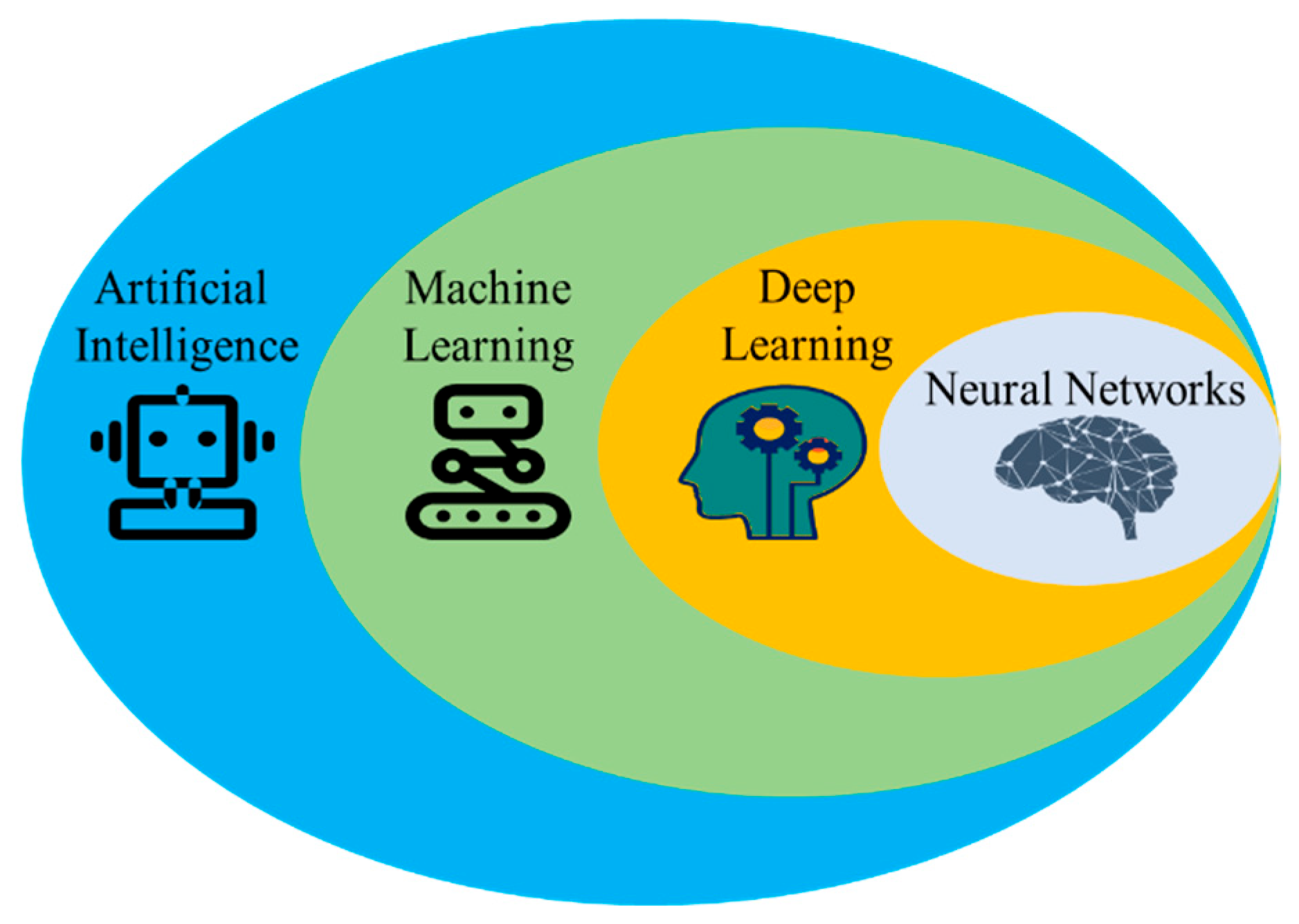


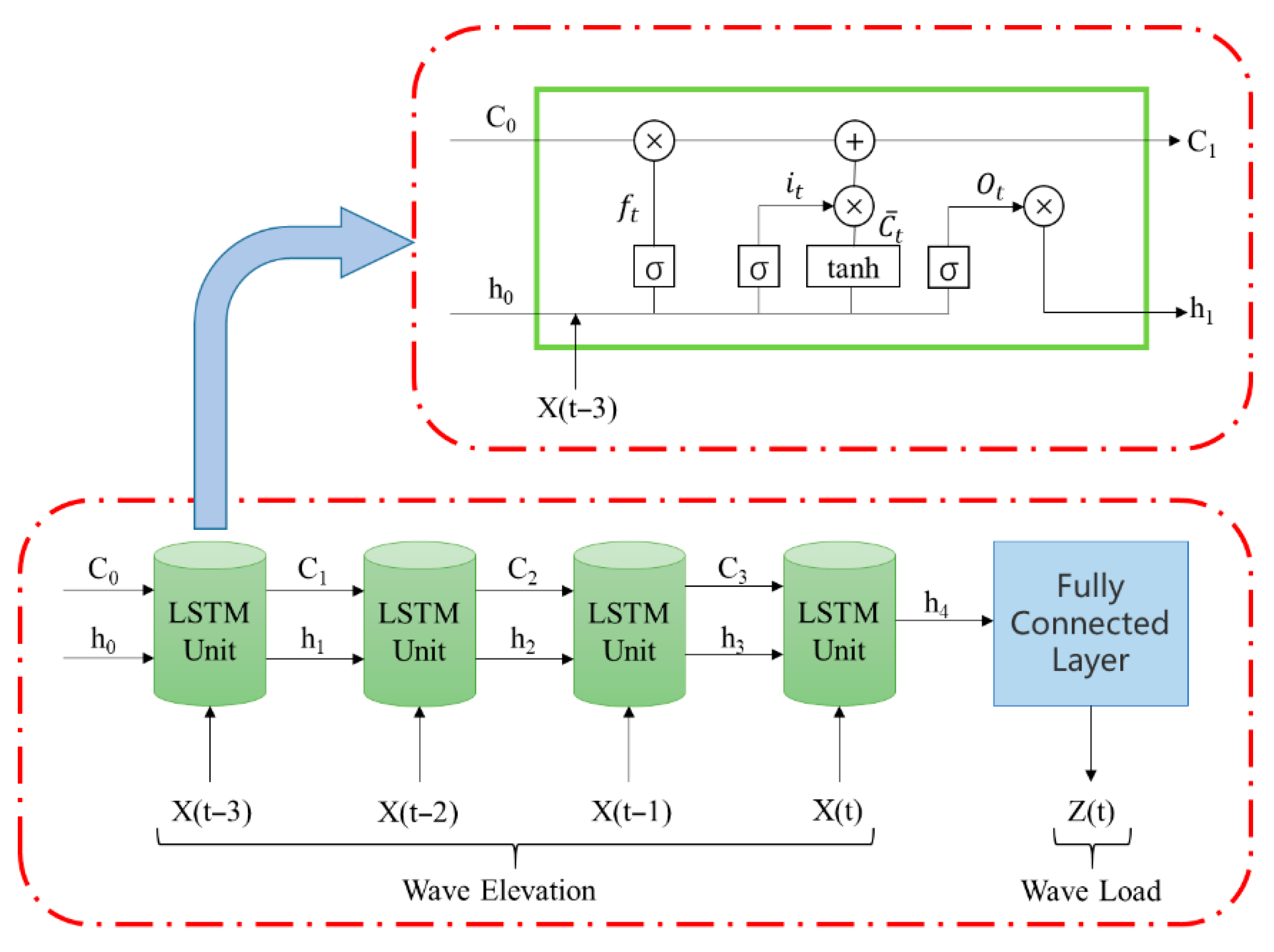

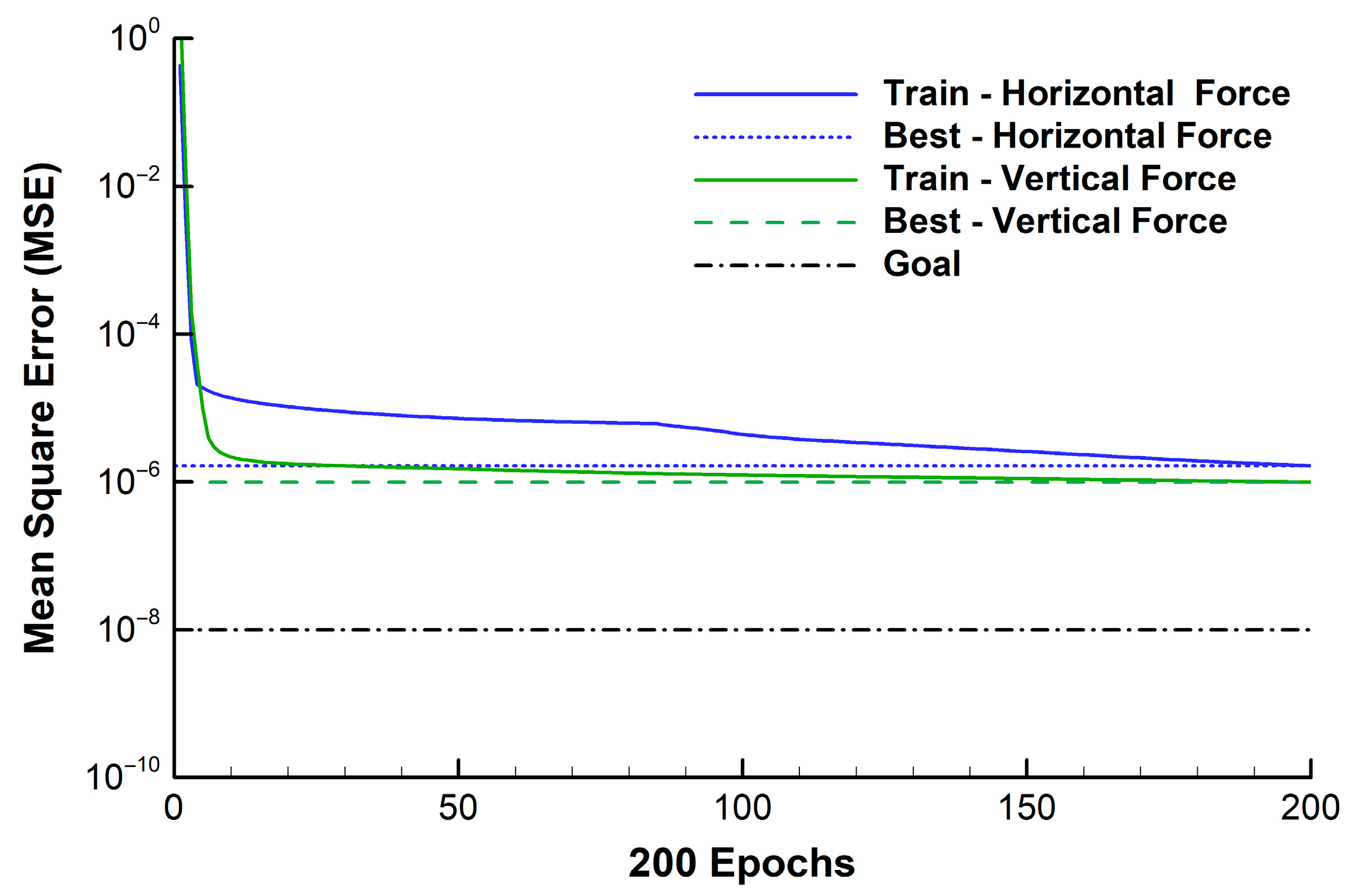
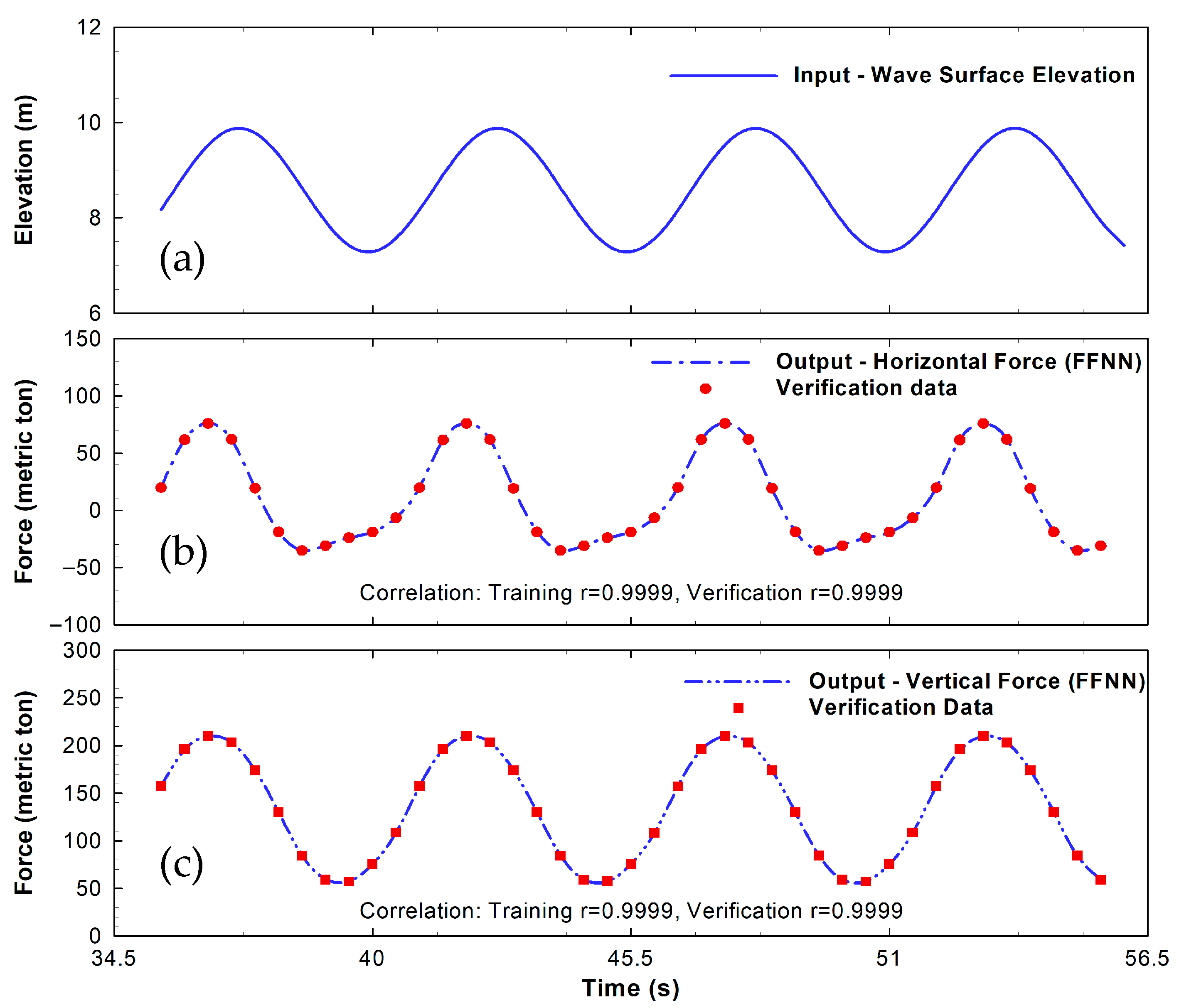



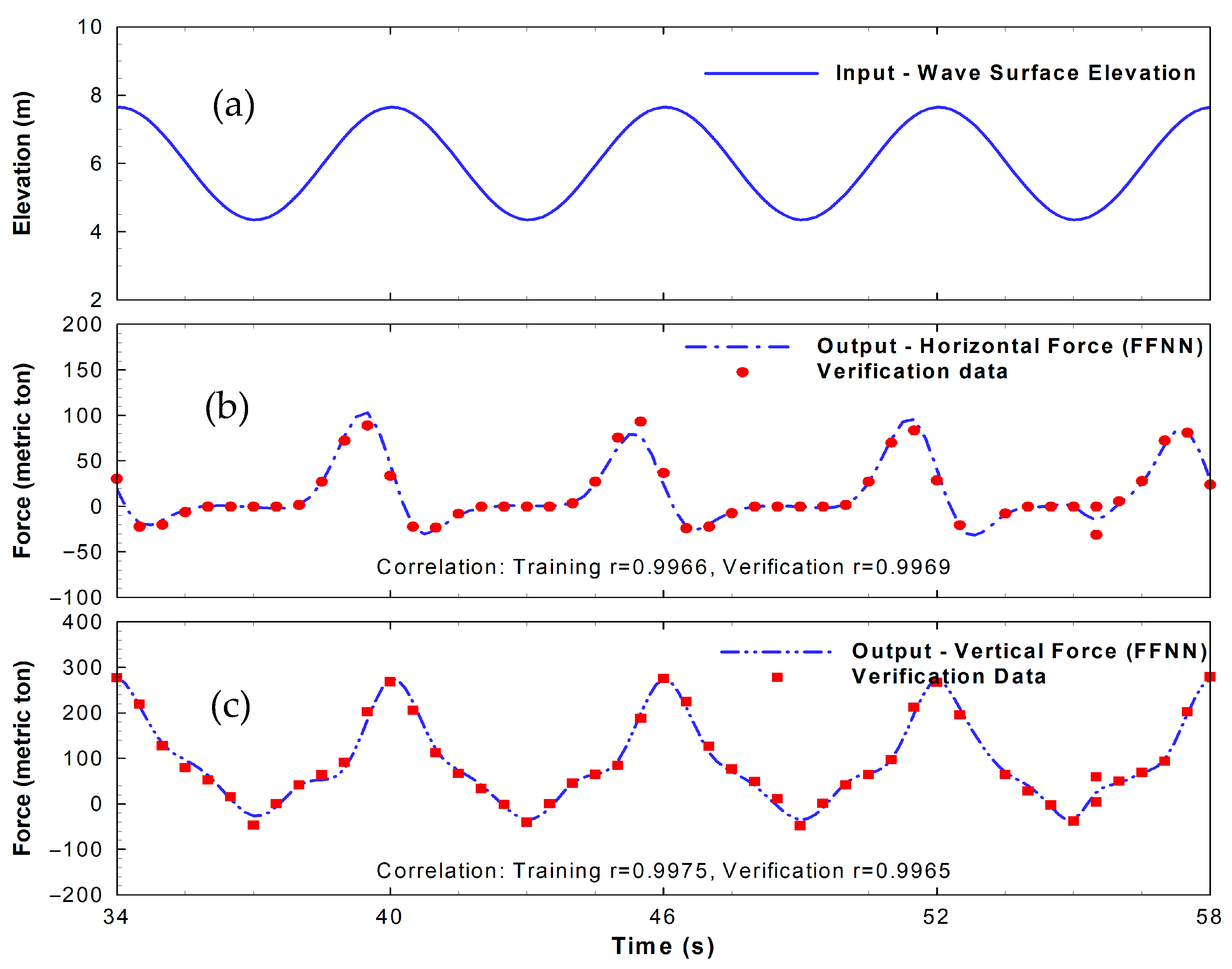
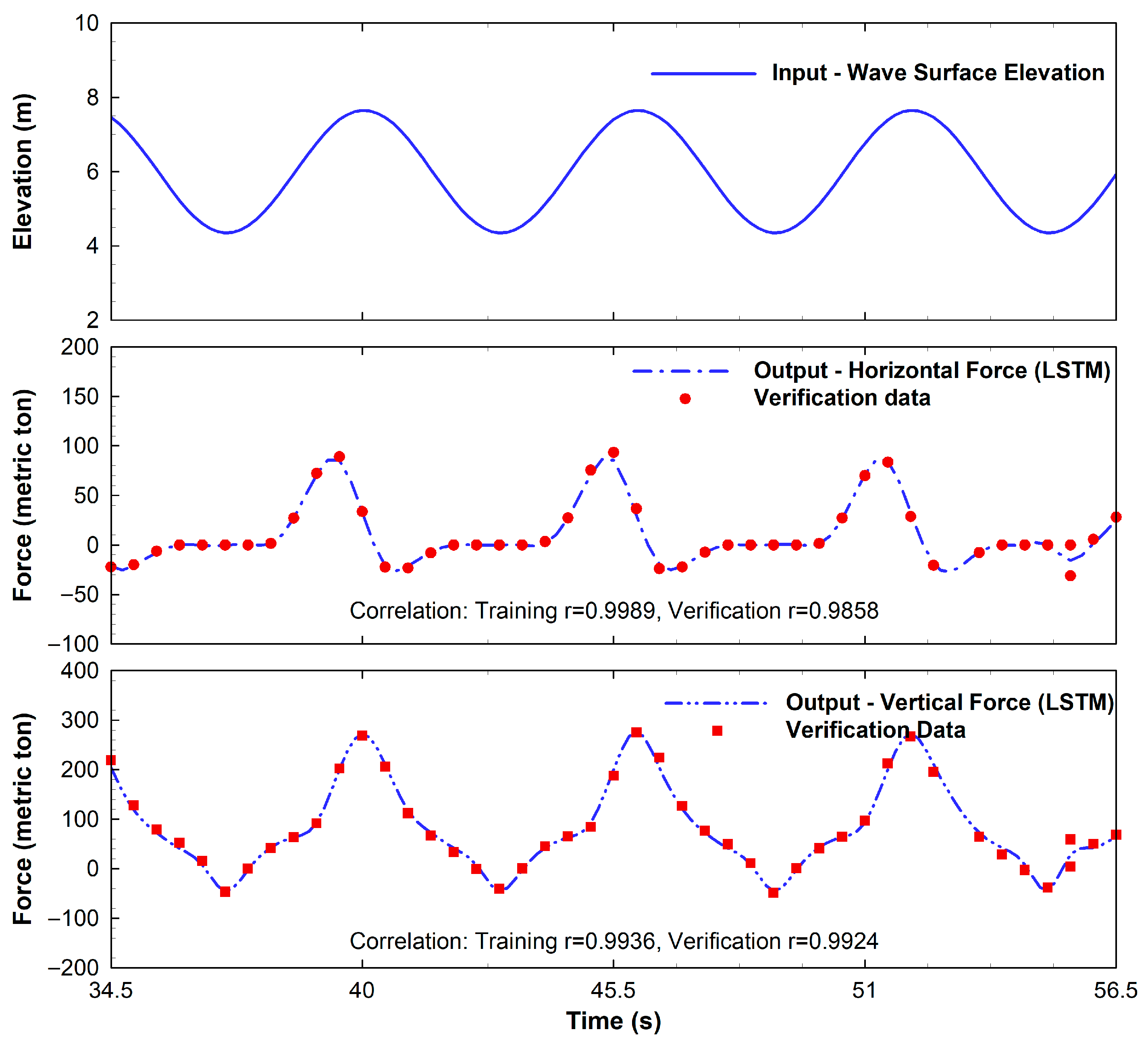
| Model * | Method | Training Time (s) | Validation Time (s) | Correlation Coefficient r | RMSE |
|---|---|---|---|---|---|
| LSTM with 15 hidden units | Sgdm | 3.6800 | 0.0407 | 0.9852 | 0.0745 |
| Rmsprop | 3.6767 | 0.0436 | 0.9984 | 0.0249 | |
| Adam | 3.7123 | 0.0403 | 0.9992 | 0.0171 | |
| FFNN with 15 hidden neurons | Traingd | 0.7588 | 0.0825 | 0.9235 | 0.1888 |
| Traingdx | 0.7681 | 0.0801 | 0.9991 | 0.0187 | |
| Trainscg | 0.8188 | 0.0816 | 0.9998 | 0.0095 | |
| Trainlm | 0.9815 | 0.0804 | 0.9999 | 0.0014 | |
| Trainrp | 0.7644 | 0.0852 | 0.9997 | 0.0112 | |
| Traingdm | 0.7729 | 0.0843 | 0.9381 | 0.1559 | |
| Traincgf | 0.9922 | 0.0824 | 0.9997 | 0.0102 | |
| Traincgb | 0.8939 | 0.0830 | 0.9998 | 0.0090 | |
| Trainbfg | 1.2269 | 0.0831 | 0.9999 | 0.0072 | |
| Traincgp | 1.1964 | 0.0835 | 0.9996 | 0.0116 |
| Model * | Method | Training Time (s) | Validation Time (s) | Correlation Coefficient r | RMSE |
|---|---|---|---|---|---|
| LSTM with 15 hidden units | Sgdm | 3.6518 | 0.0399 | 0.9287 | 0.1048 |
| Rmsprop | 3.6360 | 0.0390 | 0.9869 | 0.0442 | |
| Adam | 3.6737 | 0.0388 | 0.9858 | 0.0439 | |
| FFNN with 15 hidden neurons | Traingd | 0.6668 | 0.0833 | 0.7582 | 0.2185 |
| Traingdx | 0.6588 | 0.0856 | 0.9954 | 0.0266 | |
| Trainscg | 0.7087 | 0.0813 | 0.9971 | 0.0213 | |
| Trainlm | 0.6555 | 0.0808 | 0.9969 | 0.0227 | |
| Trainrp | 0.6801 | 0.0829 | 0.9971 | 0.0211 | |
| Traingdm | 0.6665 | 0.0802 | 0.6647 | 0.2091 | |
| Traincgf | 0.8790 | 0.0836 | 0.9973 | 0.0204 | |
| Traincgb | 0.8568 | 0.0820 | 0.9965 | 0.0227 | |
| Trainbfg | 1.1120 | 0.0921 | 0.9933 | 0.0323 | |
| Traincgp | 0.8740 | 0.0831 | 0.9974 | 0.0200 |
| Methods | Neurons /Units | Training Time (s) | Validation Time (s) | Correlation Coefficient r | RMSE |
|---|---|---|---|---|---|
| FFNN-LM | 5 | 0.6484 | 0.0819 | 0.9651 | 0.0733 |
| 10 | 0.6507 | 0.0802 | 0.9835 | 0.0511 | |
| 15 | 0.6555 | 0.0808 | 0.9969 | 0.0227 | |
| 20 | 0.6589 | 0.0822 | 0.9892 | 0.0437 | |
| 30 | 0.6814 | 0.0816 | 0.9842 | 0.0490 | |
| LSTM-Adam | 5 | 3.5661 | 0.0409 | 0.9896 | 0.0394 |
| 10 | 3.5798 | 0.0397 | 0.9902 | 0.0383 | |
| 15 | 3.6737 | 0.0388 | 0.9858 | 0.0439 | |
| 20 | 3.6894 | 0.0381 | 0.9847 | 0.0479 | |
| 30 | 3.7633 | 0.0394 | 0.9849 | 0.0476 |
Disclaimer/Publisher’s Note: The statements, opinions and data contained in all publications are solely those of the individual author(s) and contributor(s) and not of MDPI and/or the editor(s). MDPI and/or the editor(s) disclaim responsibility for any injury to people or property resulting from any ideas, methods, instructions or products referred to in the content. |
© 2025 by the authors. Licensee MDPI, Basel, Switzerland. This article is an open access article distributed under the terms and conditions of the Creative Commons Attribution (CC BY) license (https://creativecommons.org/licenses/by/4.0/).
Share and Cite
Xiao, H.; Huang, W.; Wang, J. Modeling Hurricane Wave Forces Acting on Coastal Bridges by Artificial Neural Networks. J. Mar. Sci. Eng. 2025, 13, 2080. https://doi.org/10.3390/jmse13112080
Xiao H, Huang W, Wang J. Modeling Hurricane Wave Forces Acting on Coastal Bridges by Artificial Neural Networks. Journal of Marine Science and Engineering. 2025; 13(11):2080. https://doi.org/10.3390/jmse13112080
Chicago/Turabian StyleXiao, Hong, Wenrui Huang, and Jiahui Wang. 2025. "Modeling Hurricane Wave Forces Acting on Coastal Bridges by Artificial Neural Networks" Journal of Marine Science and Engineering 13, no. 11: 2080. https://doi.org/10.3390/jmse13112080
APA StyleXiao, H., Huang, W., & Wang, J. (2025). Modeling Hurricane Wave Forces Acting on Coastal Bridges by Artificial Neural Networks. Journal of Marine Science and Engineering, 13(11), 2080. https://doi.org/10.3390/jmse13112080







